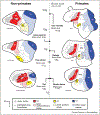Not all cortical expansions are the same: the coevolution of the neocortex and the dorsal thalamus in mammals
- PMID: 30658218
- PMCID: PMC6551301
- DOI: 10.1016/j.conb.2018.12.003
Not all cortical expansions are the same: the coevolution of the neocortex and the dorsal thalamus in mammals
Abstract
A central question in comparative neurobiology concerns how evolution has produced brains with expanded neocortices, composed of more areas with unique connectivity and functional properties. Some mammalian lineages, such as primates, exhibit exceptionally large cortices relative to the amount of sensory inputs from the dorsal thalamus, and this expansion is associated with a larger number of distinct cortical areas, composing a larger proportion of the cortical sheet. We propose a link between the organization of the neocortex and its expansion relative to the size of the dorsal thalamus, based on a combination of work in comparative neuroanatomy and experimental research.
Copyright © 2018 Elsevier Ltd. All rights reserved.
Conflict of interest statement
Conflicts of Interest
We declare no conflicts of interest.
Figures




References
-
- Goldring A, Krubitzer L: Evolution of parietal cortex in mammals: from manipulation to tool use In Evolution of Nervous Systems, Second Edition, Volume 3 Edited by Krubitzer L, Kaas J. Elsevier; 2017:259–286.
-
- Striedter GF, Srinivasan S, Monuki ES: Cortical folding: when, where, how and why? Annu Rev Neurosci 2015, 38:291–307. - PubMed
-
A synthetic review of the diverse mechanisms involved in cortical folding in mammalian brain evolution, including a new proposal for the role of radial intercalation in generating tangential expansion.
-
- Mota B, Herculano-Houzel S: Cortical folding scales universally with surface area and thickness, not number of neurons. Science 2015, 349:74–77. - PubMed

